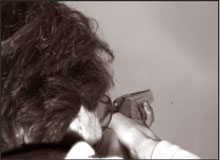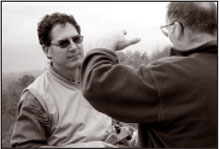The clocks have sprung forward and Springtime has most definitely
arrived. and the longer days are accompanied by some great
weather. We all recognise that an inanimate clay target
does not show the same flight characteristics of a live
bird, but taking advantage of the longer days to shoot some
clay pigeons will keep the rust off mentally, physically
and equipment-wise. Practice will keep you sharp and ready
for your first test of the next season.
This month I would like to
offer some new ideas for you to try in practice that might
just put a finer edge on your shooting.
Time spent working on the
basics at home is never wasted; gun mounting and swing drills
are a must. Visual and mental rehearsal is another favourite
practice technique that can be honed at home.The combination
of these three, when well practiced, works to establish
and reinforce muscle strength and memory.

In particular, I like the
use of a small maglite inserted in the barrel of an unloaded
gun. This can be used as a pointer, with the beam acting
has a visual reference and check to the perfected swing
and mount by tracing the joint of wall and ceiling as if
they were a target’s flight path.
When it comes to live firing
on the range, most shots consider practice to be simply
a 50 or 100 bird round at their local club. However,if this
local club is where the bulk of their shooting takes place,
they are familiar with the target presentations and very
often the targets change very little visit to visit. Often,
regardless of how well they are shooting, they will top
this off with a round of Skeet or 5-Stand, perhaps even
a second go round on the Sporting Clays course. In actuality,
all they are achieving is subjecting him or herself to a
large dose of recoil with little, if any, learning content
or improvement.
|
|
Let me qualify this by saying that if you are going out
to shoot for the enjoyment of it, then that is fine! After
all, it is a hobby and a sport and you should do it simply
for the pleasure it gives you. However, please do not confuse
that kind of sport-shooting with meaningful practice.

Here are three accepted practice formats for you to try.
The Basic Swing Builder:
Choose a particular target, it can be anything you like:
a rabbit, teal, incomer or crosser. Address the target some
20 yards away and attempt to break it half a dozen times
in a row. If successful, move back 5 yards and carry out
the same exercise. With each successful run, add an extra
5 yards and continue to push the envelope of your shooting
until you fail to shoot 6 in a row. However, if you miss
at any time you have to start over at the 20-yard mark.
This drill teaches you to
focus and concentrate on every shot. It is particularly
effective when practiced with a friend where a wager can
add some extra pressure. I would like to suggest that the
full use of a Skeet or Trap field are perfect for this exercise
and one or two boxes of shells are a perfect number with
which to practice. The emphasis should be on crushing one
bird at a time, all the way back to the 40-yard mark.
The Intermediate Swing Builder:Once again,
select a suitable target, preferably one that makes you
struggle; let’s say a rabbit directly crossing at
about 25 to 30 yards. First, just shoot it in your usual
style. When you are breaking half a dozen straight, consistently,
|
|
you should attempt to
shoot the target using a different technique.
If you are a Swing-Through
shooter, try Pull-Away, if a Maintained -Lead shot then
use Swing-Through. You should be prepared to miss when you
first attempt this. However, with practice over a few weeks,
you will soon be able to tackle any target presentation
with the best technique for a better score.
This improved flexibility
in your shooting will gain you extra birds next season.
Once again, one or two boxes of shells are all that is required,
once a week. The Skeet range is great for this kind of shooting
skills practice. I do not know of any top shooter who, when
called on to do so by the target presentation, cannot shoot
all three of the techniques, regardless of his chosen favourite.
They can read the targets, choose the technique and, as
if changing gears, they can apply it.

I would like to mention here
that the only differences between the techniques is where
the gun muzzle is inserted on the target. Insert behind
and you will shoot Swing Through…insert on it and
you will shoot Pull Away, insert in front and the result
will be Maintained-Lead. The basics are the same regardless
of the technique chosen.

|
|
